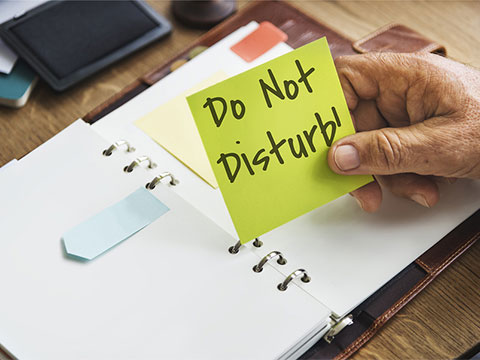
We recently discussed the growing criticism of open office layouts, largely because of the noise and distractions that can undermine productivity. Nonetheless, open floor plans are likely here to stay, experts say, because they’re cheaper to build than private offices or cubicles.
So, the question remains: How can you bring a little enclosure to your open office when you and your team need to get some intensive work done?
Flexible Work Areas Are Key
Jonathan Webb, vice president of workplace strategy at KI, a large Wisconsin-based furniture supplier for offices and institutions, says flexibility is key. “The best way to improve an open office plan is to create multiple work areas that support a variety of employees and work styles—those who prefer open office areas, those who prefer more privacy, and everyone in between,” Webb told
The FruitGuys Magazine .
If your standard workspace doesn’t offer many buffers from distracting interactions and interruptions, provide designated spaces where people can focus. Let staff know they can work in designated quiet spaces, such as free conference rooms or in the lunchroom outside of mealtimes. If you’re a manager, educate employees that when someone moves to a quiet space to work, this is a signal to not interrupt them. Budget and space permitting, set aside or construct some private “focused-work” spaces for staff to use, whether it’s a closed-wall office or an old-fashioned phone booth for people to make private or sensitive calls.
Likewise, setting clear expectations for focused productivity times for the whole office, when social interaction is discouraged, can help everyone. These may last from 10 a.m. to 11:30 a.m. and 1:30 p.m. to 3:30 p.m., for example, depending on what times make the most sense for your business.
Want farm-fresh fruit?
Get your office a free sample TODAY!
Four Tips to Minimize Distractions
High-privacy spaces aren’t always an option, and in that case, here are our top four tips to create your own sacred space:
1. Set Boundaries
Practice telling colleagues when you need less interaction. Try, “I’m sorry, I really need to finish this report. Let’s catch up later, OK?” Or maybe, “I’m sorry, but I don’t really follow [football/Kardashians/Game of Thrones/politics], do you mind if I get back to work?” Courteous and clear communication can go a long way in creating a less distracting workspace.
2. Hang a sign

Understandably, telling someone that you aren’t able to talk to them in the moment may be a bit uncomfortable. Some people will take it personally, regardless of intention and delivery.
A “Do Not Disturb” sign or light will signal anyone approaching and can take the sting out of setting boundaries. Several companies sell signalling devices for phone systems, and some (such as the Kuando Busylight, $44.95) coordinate with other systems, such as Skype For Business and Cisco Jabber. The downside to this option is that you have to be on the phone to change the light, but under the right circumstances, it can help reduce interruptions.
If you take the sign route, it’s important to change your sign to fit your actual availability. A “Do Not Disturb” sign left up all the time will be quickly ignored.
There are hundreds of “Do Not Disturb”-type signs on Etsy or simply print your own. Expressing the appropriate and fitting tone with your sign will depend a lot on your office culture and individual personality.
3. Use Headphones or Earbuds
Learn from subway riders and millennials everywhere: a visible listening device discourages conversation—even if it’s not plugged in. If earbuds are too subtle a hint for your coworkers to pick up on, try a pair of noise-cancelling headphones or cold-weather earmuffs as a more direct signal to your coworkers that you want to be left alone to work.
4. Find a New Space
Well, not exactly. But if your supervisor allows it, working from home, a nearby coffee shop, or a library can provide an alternative environment and escape from your usual distractions. Background conversation among strangers may be inherently less distracting because the voices and speakers aren’t familiar, making us less likely to be drawn in, according to David Burkus, who looked at studies of ambient noise and its impact on workers in his piece for The Harvard Business Review, “Why You Can Focus in a Coffee Shop but Not in Your Open Office.” Co-working spaces can offer similar benefits—a sense of being surrounded by others while you work, without the workplace distractions—as long as you don’t get caught up in what others are doing, and they leave you alone to finish your tasks.
Whichever tactic you use, try to keep a balance between privacy and socialization. Don’t let your legitimate need to focus morph into aloofness or isolation, or your work and your working relationships could suffer. And remember, no matter how demanding your job tasks are, everyone needs to take a breather from time to time. As Webb notes, “The fact is that no one can be their most productive and focused self from 9-to-5, Monday through Friday, without some time to rest and wind down.” That’s when an open office design provides a good opportunity to socialize a bit, check-in with your workers, and recharge your batteries.
There’s a rhythm to the workday, a push and pull between solitary focus and group interaction, all in the name of positive and engaging productivity for everyone involved. An open office can make the solitary part challenging at times, but your goal should always be to give each its due.
Want farm-fresh fruit?
We've got you covered.
Mark Saltveit is the author of The Tao of Chip Kelly (Diversion Books, 2013) and Controlled Chaos: Chip Kelly’s Football Revolution (Diversion Books, 2015). His work has appeared in Harvard Magazine, the San Jose Mercury News, the Philadelphia Inquirer, and the Oregonian, as well as on his blog Taoish.org and on Warp, Weft, and Way, an academic blog about Chinese philosophy.




